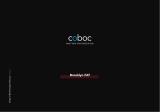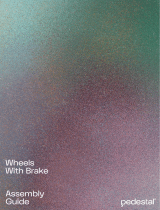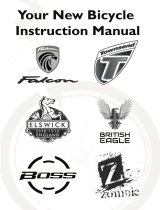
MTB/ ROAD BIKE/ TREKKING
7.8.1 Check rim brakes and cable
(racing bike version) ....................................... 33-34
7.8.2 Check rim brakes and cable
(mountain bike version) ...................................... 34
7.8.3 Check hydraulic rim brakes ................................. 35
7.8.4 Check hydraulic disc brake ........................... 35-36
7.8.5 Check back pedal brake ...................................... 36
7.9 Check drive train and chain ............................... 36
7.10 Check lighting set ........................................... 36-37
7.11 Check carrier ........................................................... 37
7.12 Check splash guards (mudguards) .................. 37
7.13 Other checks ..................................................... 37-38
8 Adjusting and using your bike ......... 38
8.1 Adjusting the adjustable
stem (optional) ...................................................... 38
8.2 Adjust saddle position .................................. 38-39
8.3 Adjust saddle height ............................................ 39
8.4 Adjust suspension fork ........................................ 39
8.5 Adjust rear suspension ....................................... 40
8.6 Service the gear ............................................... 40-41
8.6.1 Shimano Rapidre/ Shimano Rapidre
2-Way-Release/Shimano EZ Fire ...................... 42
8.6.2 SRAM gear shift ...................................................... 43
8.6.3 Twist grip shift ........................................................ 43
8.6.4 Shimano STI ............................................................. 44
8.6.5 Sram Force / Rival / Red ....................................... 44
8.7 Service the brakes ................................................. 45
8.8 Operate the quick-release action .............. 45-48
8.9 Using click-in pedals (optional) .................. 48-49
8.10 Loading the carrier ................................................ 50
9 During riding (Troubleshooting) .......... 50
9.1 Gears and drive train ............................................ 51
9.2 Brake .......................................................................... 52
9.3 Frame and suspension .................................. 52-53
9.4 Splash guard,
carrier and lighting set ........................................ 53
9.5 Road wheels and tryes ........................................ 54
10 After falls or accidents ...................... 55
11 Transporting your bike ...................... 55
11.1 Fit and remove road wheels ................................ 56
11.1.1 All categories/series except the
category racing bike/triathlon ................... 56-60
11.1.2 Race/ Triathlon ................................................... 60-63
11.2 Remove and replace seat post
and saddle ........................................................... 63-64
12 Cleaning and caring
for your bike .................................. 65-67
13 Storing your bike for a
lengthy period .................................... 67
14 Warranty and Guarantee ..................
68
14.1 Warranty ..................................................................... 68
14.2 Guarantee .................................................................. 68
14.3 Warranty Policy ....................................................... 68
14.4 Warranty claim / warranty is void ..................... 68
15 Handover inspection checklist ......... 69
Handover certicate
Content
1 About this Owner’sManual ............... 07
1.1 Conventions .............................................................. 07
1.1.1 Symbol......................................................................... 07
1.1.2 Location indications ............................................... 07
1.1.3 List of abbreviations................................................ 07
1.1.4 Denition of Terms .......................................... 07-08
1.2 Owner’s Manual ................................................ 08-09
1.2.1 Scope of Application ............................................ 09
1.2.2 Accompanying Documentation ........................ 09
1.2.3 Pictures ....................................................................... 09
2 For your safety .................................. 09
2.1 Use your bicycle as intended ............................. 09
2.1.1 Who may use your bicycle? ................................ 09
2.1.2 How may you ride your bicycle? ....................... 10
2.1.3 Where may you ride your bicycle? .............. 10-12
2.1.4 In what condition must your bike be in
when you ride it? ...................................................... 13
2.1.5 Accessories and modication ....................... 13-14
2.1.6 Transport of children, baggage,
bicycle trailers ........................................................... 14
2.1.7 Roller training .................................................... 14-15
2.2 Other hazards ............................................................ 15
2.2.1 Hazards caused by faulty
nal assembly ............................................................ 15
2.2.2 Hazards caused by improper use ....................... 15
2.2.3 Risk of burns ............................................................... 15
2.2.4 Other hazards and safety notes ................... 15-16
2.3 Disposal ....................................................................... 16
3 Scope of Supply,
Technical Data ................................... 16
.
3.1 Scope of supply ....................................................... 16
3.2 Technical data ........................................................... 16
3.3 Torques of screw connections ............................ 17
4 Assembly and function ..................... 17
4.1 Categories ................................................................... 17
4.2 Categorie/ Models ................................................... 18
4.2.1 Kids Bikes / Category 0 .......................................... 18
4.2.2 Racing bike / Triathlon and time trial bikes /
Category 1 ................................................................ 18
4.2.3 Fitness bike/ Urban bike/ Category 1.............. 18
4.2.4 Cross bike / Category 2 ......................................... 18
4.2.5 Trekking bike/ Trekking bike HYBRID/
Category 2 ................................................................ 19
4.2.6 Cyclocross/ Category 2 .........................................19
4.2.7 Hardtail/ Hardtail HYBRID/ MTB with
suspension forkl/ Category 3 ............................ 20
4.2.8 Fully/ Fully HYBRID Category 4 ......................... 20
4.2.9 Fully MTB Category 5 ......................................... 20
4.2.10 Downhill bike Category 6 ................................. 21
4.8 General information ............................................. 22
4.8.1 Brakes ....................................................................... 22
4.8.2 Gear shift ................................................................. 22
4.8.3 Frame and fork ....................................................... 22
4.9 Frame material / information
on carbon material ......................................... 22-23
4.9.1 Information on the frame construction ........ 23
4.9.2 How to use your carbon
parts correctly .................................................. 23-24
5 Bicycle frame/
Bicycle frame set ............................... 24
6 Before using for the rst time .......... 25
7 Before every trip .......................... 25-26
7.1 Check the road wheels ........................................ 26
7.1.1 Check tting ........................................................... 27
7.1.2 Check the rims ....................................................... 27
7.1.3 Check tyres ....................................................... 28-29
7.1.4 Other checks ........................................................... 29
7.2 Check saddle and seat post ............................... 30
7.3 Check handlebars and stem ........................ 30-31
7.4 Check handlebar-mounted parts .................... 31
7.5 Check the fork bearing ................................. 31-32
7.6 Check suspension fork ....................................... 32
7.7 Check the rear wheel suspension .................... 32
7.8 Check the brakes ............................................. 32-33
























